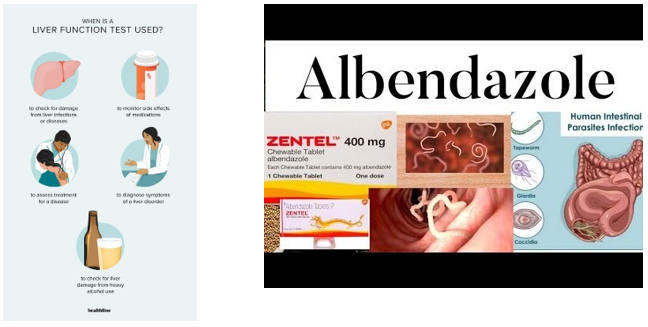A client who is taking albendazole reports experiencing fatigue, nausea, and dark urine. The nurse observes a yellowing of the client’s skin and sclera. Which lab results should the nurse review?
Renal function panel.
Thyroid function test.
Basic metabolic panel
Liver function test.
The Correct Answer is D
The client's symptoms suggest liver dysfunction, which is a known adverse effect of albendazole. Albendazole is primarily metabolized in the liver, and its use can cause liver damage in some cases. Therefore, it is essential to review liver function test results to assess the severity of liver damage and to determine if the medication should be discontinued or the dosage should be adjusted.
The renal function panel (a) measures the levels of various substances, such as creatinine and blood urea nitrogen, in the blood to assess kidney function.
The thyroid function test (b) evaluates the levels of thyroid hormones in the blood to diagnose thyroid disorders.
The basic metabolic panel (c) includes several tests that assess the levels of electrolytes, glucose, and other substances in the blood to evaluate metabolic function. However, these lab tests are not directly related to the symptoms and adverse effects associated with albendazole use

Nursing Test Bank
Naxlex Comprehensive Predictor Exams
Related Questions
Correct Answer is C
Explanation
Restless legs syndrome is a condition that causes an uncomfortable sensation in the legs and an uncontrollable urge to move them. Melatonin is a natural hormone that helps regulate the sleep-wake cycle and can be used as a sleep aid. Therefore, when evaluating the effectiveness of melatonin in an older adult client with restless legs syndrome, the nurse should assess the client's sleep patterns to determine if the herb is improving their ability to fall and stay asleep.
Assessing anxiety level (a) may be useful in other contexts, but it is not directly relevant to evaluating the effectiveness of melatonin for restless legs syndrome. Observing for peripheral edema (b) and palpating pedal pulse volume (d) are important assessments in clients with peripheral vascular disease or other circulatory disorders, but they are not directly related to restless legs syndrome or the use of melatonin.

Correct Answer is C
Explanation
A. Administers onto the fleshy outer thigh: This is the recommended site for epinephrine auto-injection because it allows for quick absorption into the bloodstream. The outer thigh is a large muscle area, which helps in the rapid distribution of the medication.
B. Inserts the injection pen through clothing: It is generally acceptable to inject epinephrine through clothing in an emergency situation. This practice ensures that there is no delay in administering the life-saving medication, which is crucial during an anaphylactic reaction.
C. Cleanses the injection pen for re-use: Epinephrine auto-injectors are designed for single use only. Reusing the pen can lead to contamination and reduced effectiveness of the medication. It is important to dispose of the used injector properly and obtain a new one for future use.
D. Holds the pen in place after injection: Holding the pen in place for a few seconds after injection ensures that the full dose of medication is delivered. This practice helps in maximizing the effectiveness of the treatment during an anaphylactic emergency.
Whether you are a student looking to ace your exams or a practicing nurse seeking to enhance your expertise , our nursing education contents will empower you with the confidence and competence to make a difference in the lives of patients and become a respected leader in the healthcare field.
Visit Naxlex, invest in your future and unlock endless possibilities with our unparalleled nursing education contents today
Report Wrong Answer on the Current Question
Do you disagree with the answer? If yes, what is your expected answer? Explain.
Kindly be descriptive with the issue you are facing.
